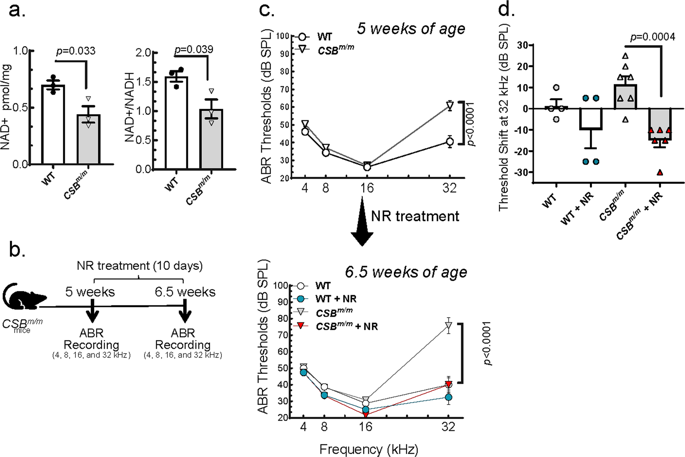当前位置:
X-MOL 学术
›
npj Aging Mech. Dis.
›
论文详情
Our official English website, www.x-mol.net, welcomes your feedback! (Note: you will need to create a separate account there.)
Short-term NAD+ supplementation prevents hearing loss in mouse models of Cockayne syndrome.
npj Aging and Mechanisms of Disease Pub Date : 2020-01-07 , DOI: 10.1038/s41514-019-0040-z Mustafa N Okur 1 , Beatrice Mao 2 , Risako Kimura 1 , Scott Haraczy 2 , Tracy Fitzgerald 3 , Kamren Edwards-Hollingsworth 2 , Jane Tian 1 , Wasif Osmani 1 , Deborah L Croteau 1 , Matthew W Kelley 2 , Vilhelm A Bohr 1, 4
npj Aging and Mechanisms of Disease Pub Date : 2020-01-07 , DOI: 10.1038/s41514-019-0040-z Mustafa N Okur 1 , Beatrice Mao 2 , Risako Kimura 1 , Scott Haraczy 2 , Tracy Fitzgerald 3 , Kamren Edwards-Hollingsworth 2 , Jane Tian 1 , Wasif Osmani 1 , Deborah L Croteau 1 , Matthew W Kelley 2 , Vilhelm A Bohr 1, 4
Affiliation

|
Age-related hearing loss (ARHL) is one of the most common disorders affecting elderly individuals. There is an urgent need for effective preventive measures for ARHL because none are currently available. Cockayne syndrome (CS) is a premature aging disease that presents with progressive hearing loss at a young age, but is otherwise similar to ARHL. There are two human genetic complementation groups of CS, A and B. While the clinical phenotypes in patients are similar, the proteins have very diverse functions, and insight into their convergence is of great interest. Here, we use mouse models for CS (CSA -/- and CSB m/m ) that recapitulate the hearing loss in human CS patients. We previously showed that NAD+, a key metabolite with various essential functions, is reduced in CS and associated with multiple CS phenotypes. In this study, we report that NAD+ levels are reduced in the cochlea of CSB m/m mice and that short-term treatment (10 days) with the NAD+ precursor nicotinamide riboside (NR), prevents hearing loss, restores outer hair cell loss, and improves cochlear health in CSB m/m mice. Similar, but more modest effects were observed in CSA -/- mice. Remarkably, we observed a reduction in synaptic ribbon counts in the presynaptic zones of inner hair cells in both CSA -/- and CSB m/m mice, pointing to a converging mechanism for cochlear defects in CS. Ribbon synapses facilitate rapid and sustained synaptic transmission over long periods of time. Ribeye, a core protein of synaptic ribbons, possesses an NAD(H) binding pocket which regulates its activity. Intriguingly, NAD+ supplementation rescues reduced synaptic ribbon formation in both CSA -/- and CSB m/m mutant cochleae. These findings provide valuable insight into the mechanism of CS- and ARHL-associated hearing loss, and suggest a possible intervention.
中文翻译:

短期NAD +补充可预防库卡因综合征的小鼠模型出现听力丧失。
年龄相关性听力损失(ARHL)是影响老年人的最常见疾病之一。由于目前尚无有效的ARHL预防措施,因此迫切需要。Cockayne综合征(CS)是一种过早衰老的疾病,年轻时会出现进行性听力丧失,但与ARHL相似。有两个人类遗传互补组CS,A和B。尽管患者的临床表型相似,但蛋白质具有非常多样的功能,因此深入了解它们的融合引起了极大的兴趣。在这里,我们使用CS的鼠标模型(CSA-/-和CSB m / m)来概括人类CS患者的听力损失。我们以前表明,NAD +是一种具有各种基本功能的关键代谢产物,其CS含量降低,并且与多种CS表型相关。在这个研究中,我们报告说,CSB m / m小鼠的耳蜗中的NAD +水平降低,并且使用NAD +前体烟酰胺核糖苷(NR)进行的短期治疗(10天),可预防听力损失,恢复外毛细胞损失并改善耳蜗健康在CSB m / m小鼠中。在CSA-/-小鼠中观察到了相似但更适度的作用。值得注意的是,我们观察到在CSA-/-和CSB m / m小鼠中,内部毛细胞的突触前区突触带数量减少,这表明CS的耳蜗缺损的收敛机制。带状突触促进长时间内快速和持续的突触传递。肋眼是突触带的核心蛋白,具有调节其活性的NAD(H)结合口袋。有趣的是,NAD +补充剂可缓解CSA-/-和CSB m / m突变型耳蜗中突触带的形成。
更新日期:2020-01-07
中文翻译:

短期NAD +补充可预防库卡因综合征的小鼠模型出现听力丧失。
年龄相关性听力损失(ARHL)是影响老年人的最常见疾病之一。由于目前尚无有效的ARHL预防措施,因此迫切需要。Cockayne综合征(CS)是一种过早衰老的疾病,年轻时会出现进行性听力丧失,但与ARHL相似。有两个人类遗传互补组CS,A和B。尽管患者的临床表型相似,但蛋白质具有非常多样的功能,因此深入了解它们的融合引起了极大的兴趣。在这里,我们使用CS的鼠标模型(CSA-/-和CSB m / m)来概括人类CS患者的听力损失。我们以前表明,NAD +是一种具有各种基本功能的关键代谢产物,其CS含量降低,并且与多种CS表型相关。在这个研究中,我们报告说,CSB m / m小鼠的耳蜗中的NAD +水平降低,并且使用NAD +前体烟酰胺核糖苷(NR)进行的短期治疗(10天),可预防听力损失,恢复外毛细胞损失并改善耳蜗健康在CSB m / m小鼠中。在CSA-/-小鼠中观察到了相似但更适度的作用。值得注意的是,我们观察到在CSA-/-和CSB m / m小鼠中,内部毛细胞的突触前区突触带数量减少,这表明CS的耳蜗缺损的收敛机制。带状突触促进长时间内快速和持续的突触传递。肋眼是突触带的核心蛋白,具有调节其活性的NAD(H)结合口袋。有趣的是,NAD +补充剂可缓解CSA-/-和CSB m / m突变型耳蜗中突触带的形成。


























 京公网安备 11010802027423号
京公网安备 11010802027423号